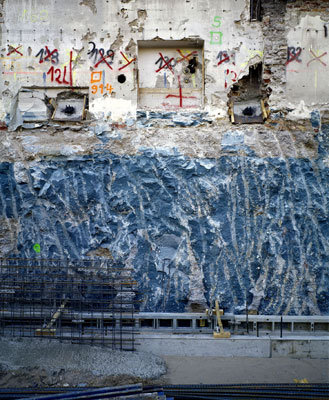Ulrich Hensel
dal 14/11/2007 al 20/12/2007
Segnalato da
14/11/2007
Ulrich Hensel
Spruth Magers Projekte, Munich
Dense Descriptiveness. Photographic Simulations

For nearly two decades, Düsseldorf artist Ulrich Hensel (b. 1946) has been working almost obsessively on a series of photography projects whose focus, though inexhaustibly variable and complex, lies overwhelmingly on one single subject: construction sites. Hensel's approach could be described as conceptual; it is not objets trouvés, but places cherchées that capture his interest. His construction sites are places where economic, technical and not least cultural activities culminate, and which thus represent dense descriptions of the sociology of the world: reality and abstraction. It would be child's play for the artist to use digital tools to paste the desired elements into his images in a way that expresses his intentions, but to do so would be to contradict the idea of his project. For Hensel is concerned with authenticity, and despite all the creative potency of digital worlds, authenticity still remains the noblest task of photography. From a formal perspective, the serial character of his images may suggest certain parallels to the school of Bernd and Hilla Becher. However, Hensel's work occupies a unique place among the photographic art to come out of Germany.
The initial impact of the photographs is due to their sheer size. Ulrich Hensel began to create large-format photographs in the early 1990s. However, size is not an end in itself; rather, it arises from the quest to create authentic, almost full-scale reproductions of his subjects. In Hensel's view, construction site photographs are compressed simulations of life - nothing more and nothing less. But he does not need to travel the world to track down his subjects, since almost all of them can be found on the construction sites of Düsseldorf itself.
Thanks to their great degree of authenticity, Ulrich Hensel's photographs have the same effect as a well-crafted film. They are easily understandable at first glance, and observers can intuitively grasp their "plot", experience the scenes they depict as familiar, and even feel as though they have seen one of the situations, or something similar to it, somewhere before. In reality, however, the places shown in the pictures function as vehicles or pretexts for Hensel to craft his photographs with the tools of a painter. This can be seen in the large planes of colour that frequently appear in depictions of various different construction materials. And it is these planes of colour, selected because they evoke the character of paintings, that allow the photographs to reveal echoes of other media. They are often abstract and sometimes minimalist: grids, dots, fastenings and iron grilles extend across the pictures in rigorous formations defined by the functions of the objects shown. They lend rhythm to the composition while simultaneously defending the more abstract, graphical quality of the photographs.
The large-format photographs are unobtrusive and complex at the same time. Two-dimensional by dint of the medium, they nonetheless suggest a degree of plasticity that, together with their size, makes observers feel as though they were standing right on the construction site - in the midst of the "plot", as it were. This effect is also one of the characteristics of a good film. The construction sites appear to have been chosen at random, yet were carefully selected. They may look ordinary, yet each is remarkable in its own right. They may look simple, yet they are complex. At times, Ulrich Hensel's photographs not only resemble stills from a film that might resume at any moment and continue telling its story, but also have the character of landscapes, carefully composed with a foreground and a middle distance. Instead of a background indicating depth, however, it is the planes and patterns of an almost poetic world of construction materials that extends into the distance. To calibrate and visibly ground his images, Hensel is always careful to include a strip of earth on the construction site. In front of this strip of reality as well as above it, he develops situations that sometimes verge on the theatrical, with curtains rising to reveal a scene that bursts almost literally into the foreground towards the observer. In real life, this is material destruction. In the art of photography, it is a necessary element of the composition of a picture. It is the variable, deceptive interplay of authenticity and simulation, of reality and abstraction, that accounts for the compelling impact of these photographs.
Andreas F. Beitin
Image: Düsseldorf, Graf-Adolf-Platz, II, 2003
For further information please contact Julia Weiß jw@spruethmagers.com
Sprüth Magers Projekte
Ludwigstrasse 7, 80539 Munich, Germany
Tuesday - Friday 11am - 2pm and 3pm - 6pm
Saturday: 11am - 2pm and by appointment



